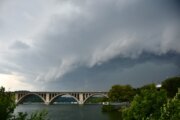If it seems like the summer months just keep getting hotter, well, there’s a reason for that. In mid-July 2024, a number of U.S. cities experienced their hottest temperatures on record. July 22, 2024, was Earth’s hottest day on record, according to a NASA analysis of global daily temperature data. July 21 and 23 of this year also exceeded the previous daily record, set in July 2023. And with a lot more summer to go, many homeowners are growing weary.
But it’s not just intense heat homeowners have to worry about. Wildfires and hurricanes have the potential to inflict a world of damage during the summer months.
There are steps homeowners can take to safeguard against heat waves and other potentially dangerous conditions that have the potential to emerge during the summer. Here are some tips to keep in mind, courtesy of Courtney Klosterman, home insights expert at Hippo home insurance.
[What Homebuyers Need to Know About Climate Change]
1. Improve Home Insulation
You can only air condition your way to a cooler interior for so long before your utility bills start to soar. And while air conditioning can bring down the temperature in your home substantially, even a hardy system won’t always get the job done by itself. That’s where insulation comes in.
“Maintaining insulation is crucial to keeping your home cool in summer,” Klosterman says. “Unsealed leaks allow conditioned air to escape, forcing your HVAC system to work harder and increasing energy bills.”
To identify the areas in your home in need of better insulation, do a walk-through. Feel around for drafts around windows, doors, outlets and plumbing fixtures. Visually inspect seals around doors and windows.
Klosterman says you can use a caulk gun to seal small cracks and gaps, but recommends canned spray foam for larger gaps. You can also apply weatherstripping to drafty doors and windows.
2. Upgrade Your Blinds and Curtains to Block the Heat
Many homeowners choose window treatments based on aesthetics, but yours may need to double as protection against the heat.
Klosterman recommends choosing light-filtering curtains to optimize temperature control during the summer. She also says, “Select window treatments that are wider than the window and extend close to the wall or window sill for maximum heat-blocking benefits.”
Along these lines, Klosterman likes to remind homeowners to keep blinds and curtains closed during the hottest parts of the day. This can minimize the strain on air conditioning systems.
[READ: Cheap Alternatives to Air Conditioning]
3. Invest in Energy-Efficient Landscaping
You don’t have to rely solely on air conditioning, insulation and window treatments to block the beating sun. Planting trees strategically, says Klosterman, could set you up for natural shade.
At the same time, though, nearby trees have the potential to turn into a hazard when strong summer storms roll in. Klosterman recommends cutting loose tree branches to minimize the likelihood of damage. Trimming tree limbs and brush can also reduce fire risks during the summer.
4. Prepare for Power Outages
Sometimes, all it takes is a 10-minute thunderstorm to cause not only property damage but also extended power outages. So Klosterman says it’s important to be prepared.
If you can afford one, a standby generator could be a great investment in your home. These generators kick on automatically when the power goes on so you’re not running cords to a portable generator and running the risk of tripping over one of them. Plus, portable generators that run on gas need to be in well-ventilated areas. Otherwise, they’re a health hazard.
And portable generators might manage to power a few appliances, but they generally won’t power your entire house. With a standby generator, you may be able to continue running your air conditioner, fridge and other appliances without skipping a beat.
If a standby generator isn’t in your budget — which it may not be, given the average $5,140 cost, according to Angi — then it’s important to have a backup plan. That means having an emergency kit ready with batteries, candles and a supply of water and nonperishable foods. Klosterman also says homeowners should identify nearby places they can go to stay cool during the summer when the power’s out, such as libraries and shopping centers.
5. Safeguard Your Home From Wildfires
The risk of wildfires tends to intensify during the summer, so it’s important to know how likely you are to end up in the path of one. To this end, Klosterman suggests using FEMA’s online map to assess your natural hazard risk.
Your homeowners insurance company may be another good resource. And if you live in an area with wildfire exposure, you may want to purchase additional coverage, Klosterman says.
Meanwhile, there are a few key steps you can take to protect your home from wildfires.
“Consider replacing your roof with a Class A-rated roof with noncombustible covering,” says Klosterman. You may want to replace your roof eaves as well, using short overhangs and flat ledges to stop embers from catching and spreading a fire.
Klosterman also says it’s important to store firewood away from your home and to clear dead vegetation. Ideally, she explains, you want to create a 30-foot defensible zone.
It’s also a good idea to replace single-pane windows with multipane, tempered glass windows with screens. And fireproof shutters are a smart investment, too.
Finally, Klosterman says, if you’re in an area that’s prone to wildfires, a sprinkler system on your property is crucial.
[Can You Build a Fireproof Home?]
6. Be Hurricane-Ready
Although hurricane season extends beyond the summer, strong storms have the potential to emerge during the warmest months of the year. Klosterman insists it’s important to know what coverage your homeowners insurance company offers.
“Standard homeowners insurance policies typically include coverage for damage caused by hurricanes, including wind,” she says. However, “flooding is not covered in a base homeowner’s insurance policy, and not all windstorm damage is covered either. Coastal area residents should consider purchasing additional wind and flood insurance.”
In addition to securing the right coverage, Klosterman recommends inspecting your roof for missing or damaged shingles and making repairs — or replacing your roof entirely if it’s older and not all that secure. You can also add hurricane straps and clips to secure your roof against strong winds.
If you’re in a hurricane-prone area, Klosterman suggests investing in storm shutters for your windows. Along these lines, install strong bolts at the top and bottom of exterior doors to prevent them from being blown open during a storm.
All told, Klosterman says preparing for severe summer weather should be a top priority for anyone who owns a home. “With increasingly frequent and severe storms, protecting your home through regular maintenance, reviewing insurance coverage and preparing an emergency checklist is essential.”
More from U.S. News
Can You Build a Hurricane-Proof House?
How Climate Change Could Impact Your Home Value
Are Impact Windows Worth the Cost?
A Homeowner’s Guide to Extreme Summer Weather originally appeared on usnews.com







